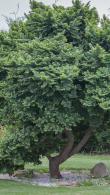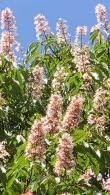Ulmus Glabra - Wych Elm
1. Add items to basket
2. Go to the basket
3. Enter your postcode in Delivery Price Check
Plant shape: Full standard
Trunk height: 1.6-1.7 m
Trunk girth: 8-10 cm
Rootball - supplied without a pot
Plant ID: 4040 100
View plant size:Plant shape: Full standard
Trunk height: 1.8 m
Trunk girth: 10-12 cm
Rootball - supplied without a pot
Plant ID: 4041 100
Plant shape: Full standard
Trunk height: 1.8 m
Trunk girth: 12-14 cm
Rootball - supplied without a pot
Plant ID: 4042 100
Plant shape: Full standard
Trunk height: 1.8 m
Trunk girth: 14-16 cm
Rootball - supplied without a pot
Plant ID: 4043 100
To check delivery cost add your plants to basket, then you can type your postcode in our Quick Delivery Price Check.
Ulmus Glabra, more commonly known as Wych Elm, is a large, deciduous tree appreciated for its lush foliage and interesting seeds in the autumn. Its impressive size and attractive appearance make it a good choice for large gardens, especially as a specimen, shade, or lawn tree. The seeds set in the centre of the fruits are larger than the English Elm (Ulmus Minor).
Early in the spring, insignificant purplish-red flowers appear before the foliage unfolds. The blossoms make way for samaras or helicopters, which are seeds encased in papery wings. The foliage of the tree is medium green, consisting of broad, ovoid, serrated leaves, that turn to yellow in the autumn.
Easy to grow and to care for, Wych Elm grows in any soil, as long as it is moist but well drained. For best results, choose deep, rich loamy soils. When it comes to location, this robust tree prefers full sun, but it will tolerate some light dappled shade. Adaptable and versatile, this cultivar is not bothered by wet or dry conditions, and will not mind urban pollution, which is why it is often chosen for an avenue or street tree.
Although more often associated with Scotland and Wales, mature, established Ulmus Glabra trees can be found throughout England. This native cultivar is fully hardy in the United Kingdom and will survive low winter temperatures and strong frosts. There are some concerns about the devastating effect Dutch Elm Disease used to have on the species during the 1960s. However the situation has improved since then. This disease has been in decline all over Europe as many naturally resistant Elms come to the fore. Increasingly newly planted trees appear to avoid the disease. Another reassurance that your tree will stay healthy is knowing that the affected specimens were never younger than 20 years old, as this disease only appeared in more mature trees.
Long-lived, and with an average growth rate, Wych Elm can reach an eventual height of 40 metres. Stately and grand, this tree requires a lot of space to fully develop, which is why it is recommended for large gardens only.
The lovely foliage and a splendid, branching habit, make this ornamental tree ideally suited for adding interest to generously sized lawns. Elegant and impressive in any landscape, Ulmus Glabra could be grown as a focus of interest in a garden, especially if underplanted with low-growing, flowering shrubs for a showier display. It makes a good shade tree because of its dense, rich canopy.
Make sure to take a look at our collection of large and mature trees, as well as our selection of deciduous trees.












